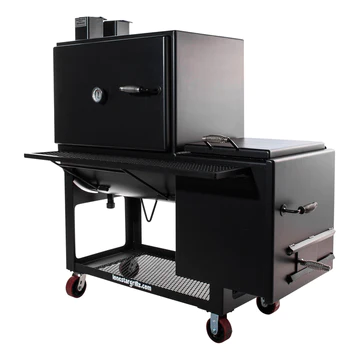In the pursuit of authentic and mouthwatering barbecue, the offset charcoal smoker emerges as a culinary marvel, combining tradition with precision. In this comprehensive guide, we’ll delve into the world of offset charcoal smokers, exploring their origins, design intricacies, cooking techniques, and the unparalleled flavor they bring to the table.
Origins and Evolution:
a. Historical Roots:
The offset charcoal smoker, rooted in centuries-old smoking traditions, draws inspiration from the ingenuity of barbecue enthusiasts. Originating from Southern barbecue culture, particularly in regions like Texas, these smokers were born out of a desire to achieve slow, even cooking and infuse meats with the unmistakable flavor of hardwood smoke.
b. Modern Advancements:
While the fundamental principles of offset charcoal smokers remain rooted in tradition, modern advancements in materials and design have elevated their performance. Today’s smokers often feature durable materials, improved insulation, and innovative airflow systems, enhancing their efficiency and making them accessible to a broader range of barbecue enthusiasts.
Anatomy of an Offset Charcoal Smoker:
a. Firebox:
The heart of an offset charcoal smoker lies in its firebox, where charcoal and wood are ignited to produce smoke. The firebox is strategically positioned to the side of the cooking chamber, allowing indirect heat to envelop the food and create a slow-cooking environment.
b. Cooking Chamber:
Connected to the firebox is the cooking chamber, where the magic happens. This large, horizontal space is where meats are placed on grates or racks, allowing them to be bathed in the flavorful smoke generated by the offset firebox. The design of the cooking chamber promotes indirect heat, resulting in tender, perfectly smoked dishes.
c. Smokestack:
At the opposite end of the cooking chamber sits the smokestack or chimney. This component plays a crucial role in maintaining proper airflow, ensuring that smoke circulates evenly around the food and exits the chamber, preventing an overpowering smoky flavor.
The Art of Smoking with Offset Charcoal Smokers:
a. Selecting the Right Wood:
Wood choice is integral to achieving the desired flavor profile. Hardwoods like oak, hickory, and fruitwoods are popular selections, each imparting a unique essence to the meat. Experimenting with different wood combinations allows smokers to craft their signature flavor.
b. Temperature Control:
One of the key skills in mastering an offset charcoal smoker is temperature control. The distance between the firebox and cooking chamber, coupled with the type and amount of fuel used, influences the cooking temperature. Seasoned pitmasters learn to fine-tune these variables to achieve the perfect balance of heat for various cuts of meat.
c. Patience is a Virtue:
Offset charcoal smokers embody the ethos of slow and low cooking. Patience is essential, as meats slowly absorb the smoky essence, rendering them tender and imbued with a rich, complex flavor. This methodical approach distinguishes offset smoking from other forms of grilling and barbecuing.
Choosing the Right Offset Charcoal Smoker:
a. Size Matters:
Selecting the appropriate size of an offset charcoal smoker depends on individual needs. Larger smokers accommodate more significant quantities of meat and offer more cooking space, ideal for entertaining large groups. Smaller models are suitable for those with limited space or smaller gatherings.
b. Material Quality:
Investing in a high-quality offset charcoal smoker ensures longevity and consistent performance. Look for models constructed from thick gauge steel, which retains and distributes heat effectively. Well-built smokers often come equipped with sturdy hinges, handles, and dampers for easy operation.
c. Budget Considerations:
Offset charcoal smokers are available across a wide price range. While high-end models offer advanced features and exceptional craftsmanship, budget-friendly options can still deliver excellent results. Consider your budget, cooking needs, and long-term aspirations when making a purchase.
V. Maintenance and Care:
Proper maintenance is crucial to the longevity and performance of an offset charcoal smoker. Regular cleaning of grates, removal of ash, and inspection of seals and gaskets contribute to optimal functionality. Seasoning the smoker with oil helps prevent rust and enhances its ability to impart flavor to the food.
The Culinary Experience:
a. Flavorful Results:
The hallmark of offset charcoal smokers is the unparalleled flavor they impart to meats. The slow, indirect cooking method, coupled with the infusion of hardwood smoke, results in succulent, flavorful dishes that captivate the taste buds.
b. Versatility in Cooking:
Offset charcoal smokers are versatile cooking apparatuses. From brisket and ribs to poultry and fish, these smokers accommodate a variety of meats, allowing enthusiasts to explore and refine their culinary skills.
c. Community and Tradition:
The use of offset charcoal smokers often transcends the act of cooking; it becomes a communal and traditional experience. Gatherings around the smoker, sharing stories and savoring expertly smoked meats, create lasting memories and foster a sense of community.
Future Trends in Offset Charcoal Smokers:
As the love for traditional barbecue methods continues to grow, the future of offset charcoal smokers holds exciting possibilities. Innovations in design, materials, and technology are likely to enhance user convenience while preserving the timeless art of slow and low smoking.
Conclusion:
In the world of outdoor cooking, the offset smoker stands as a testament to the art and science of barbecue. From its historical roots to modern innovations, this versatile apparatus has captured the hearts of barbecue enthusiasts worldwide. Mastering the art of offset charcoal smoking not only results in mouthwatering dishes but also fosters a deep connection to culinary traditions and the joy of sharing flavorful experiences with friends and family.

